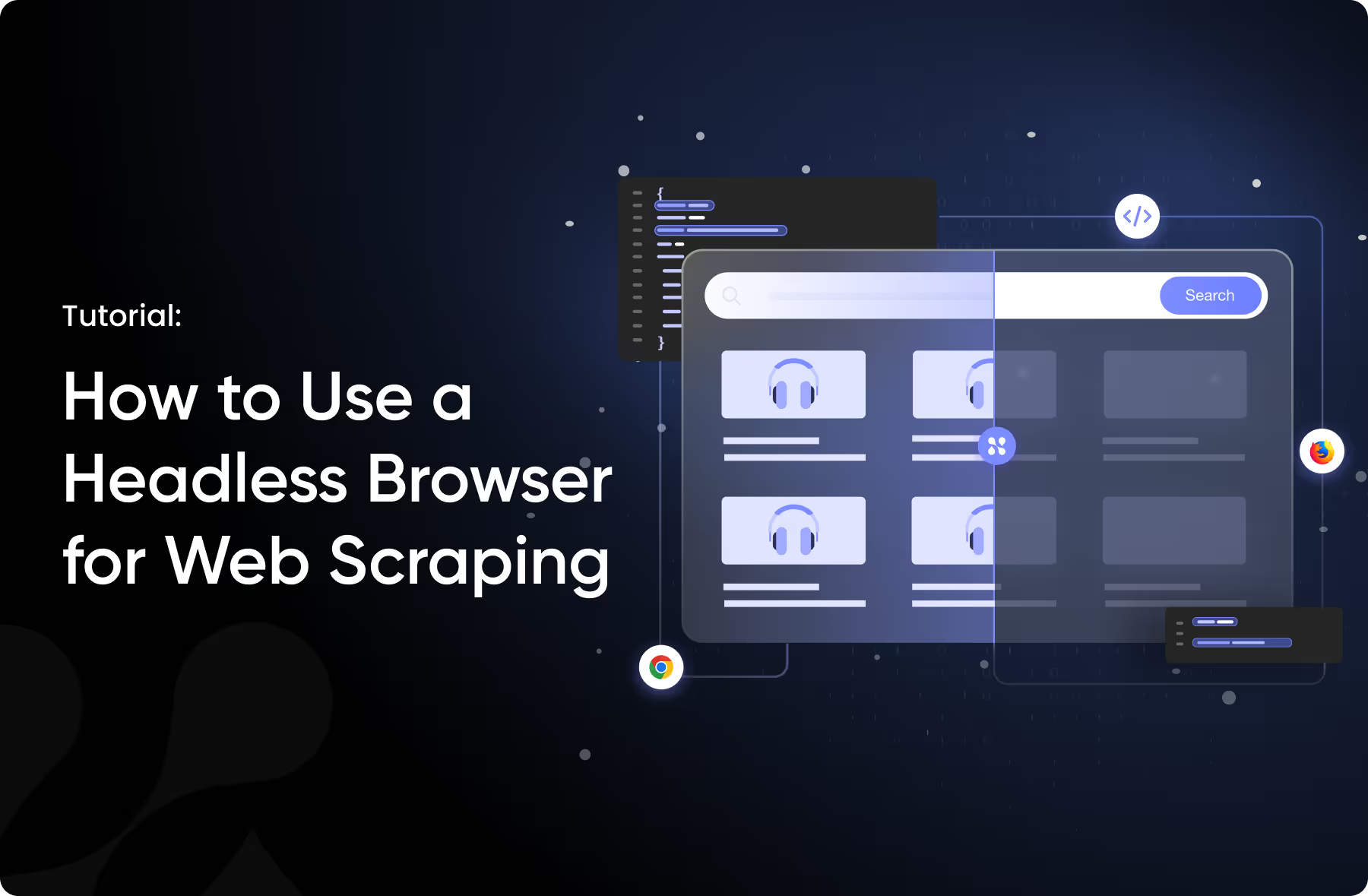What Is a Headless Browser? Uses, Benefits, and Automation Tools
Learn what a headless browser is, how they’re used, and why they’re essential for web scraping and testing.


Headless browsers are foundational for saving time, resources, and bandwidth in web scraping and software testing, especially when these activities are done at scale. Because headless browsers allow websites to load without a graphical interface and are compatible with automation, they’re a popular choice for a wide range of uses where you need to access a website but don’t need to waste energy loading the visual layout.
If you’re new to web scraping and aren’t familiar with headless browsers, this article will cover the basics of what a headless browser is, what headless browsers are used for, and when you should choose them over other options.
What Is a Headless Browser?
A headless browser is a web browser without a graphical user interface (GUI). Headless browsers can perform all the regular tasks of a traditional browser like Chrome or Safari—such as page navigation, interactions, and executing javascript—they just don’t render visual components like buttons, images, videos, icons, and other similar elements.
Essentially, a headless browser simulates how bots and crawlers view the internet. Instead of loading the visuals and UI as a human would see it, headless browsers simply interact with a website’s code and display the HTML through your command-line interface or a headless browser API.
This headless browser tutorial from Matthew Edgar at Elementive can give you an idea of what using a headless browser actually looks like. Skip to 3:10 for a simple tutorial on using headless Chrome.
Who Uses Headless Browsers?
Headless browsers are typically used by software developers in backend environments for tasks like web scraping, performance monitoring, and testing software and website functionality. They have grown in popularity because they don’t need to spend bandwidth loading a website’s GUI, which makes them faster and more efficient than alternative methods.
Headless Browser vs. Traditional Browser: Key Differences
While both traditional and headless browsers can load and interact with web pages, there are key features headless browsers have that traditional browsers don’t:
- No GUI Rendering: Traditional browsers like Chrome or Firefox render a website visually, whereas headless browsers process the page without displaying it.
- Efficiency: Headless browsers save resources, as they don't need to render the graphical elements, making them faster for automation tasks.
- Back-end and Automation-Focused: Developers primarily use headless browsers for automation and testing, whereas traditional browsers serve end users.
How Headless Browsers Work
Unlike regular browsers that allow users to access websites by interacting with a graphical interface, headless browsers access websites through a command-line interface, network communication, or a headless browser API.
Once a website is accessed, the headless browser executes the web page’s code in the background. As the website loads, multiple layers like HTML, CSS, and Javascript must be processed to render a page. Headless browsers parse and process these elements but skip the rendering step—allowing full access and functionality to the page without a visible UI.
Headless browsers are usually paired with browser automation tools like Selenium and Puppeteer.
How Headless Browsers Enable Automation & Scraping
Sometimes tools like Selenium and Puppeteer are called “headless browsers,” but this is a common confusion. In reality, these tools are browser automation tools, which are almost always paired with headless browsers but are not themselves headless browsers.
You can think of the two concepts like peanut butter and jelly—they’re different things, but you rarely use one without the other.
Browser automation tools rely on headless browsers to run automated scripts without requiring a visual interface. These technologies allow developers to automate tasks, mimic human interaction, and send instructions (e.g., "click this button" or "scroll down") to the browser, which performs the task in the background and returns the results.
For example, Puppeteer is widely used to automate Chrome in headless mode. It interacts with page elements, navigates between pages, and even takes screenshots or generates PDFs.
Practical Uses of Headless Browsers in Automation and Testing
Headless browsers are typically used for two functions: web scraping and testing.
Leveraging Headless Browsers for Web Scraping and Data Extraction
Many novice web scrapers initially try writing basic scripts that extract or fetch HTML from webpages using a traditional browser. While this works for simple, static sites, it becomes inefficient and difficult to scale when dealing with modern, dynamic websites that rely heavily on JavaScript—aka, most websites worth scraping.
In these cases, each webpage must be reverse-engineered to replicate the JavaScript behavior in your script. If done incorrectly, you'll fail to extract the required data. Additionally, failing to render JavaScript or making your scraping appear too predictable or programmatic is an easy way to trigger a website’s anti-scraping mechanisms and get your IP address blocked.
Headless browsers for scraping solve these problems by offering the following advantages:
Automation of User Interactions
When paired with browser automation tools, headless browsers allow you to simulate actions like clicks, scrolling, and form submissions. This saves you time by automating the navigation of dynamic content. It also makes your automated behavior appear more human-like, which enables you to avoid anti-scraping protections.
Easy Handling of Dynamic Content
Headless browsers can load JavaScript-heavy content without requiring you to adjust your scraping code for every new website, making them ideal for scraping data from modern, interactive web pages. Correctly rendering JavaScript also prevents you from getting flagged by anti-scraping protections.
Scalability
By eliminating the need to render pages visually and allowing the use of automation, headless browsers can scrape large amounts of data more quickly than traditional browsers and other scraping methods.
Automated Testing with Headless Browsers
Headless browsers are also widely used to test different functionalities and features of websites and web applications. Headless browsers can be used for manual testing but are more popular for automated testing—or testing that runs tests via automated scripts or software.
Headless browsers allow developers to run tests that simulate real user interactions without loading a website’s graphical interface. This makes testing faster, more efficient, and more scalable, which is especially important for repetitive or continuously conducted tests.
Here are some of the main advantages headless browsers offer for testing:
Faster and More Efficient Test Execution
Because headless browsers don’t render the graphical interface, tests can be completed more quickly and efficiently, saving time for developers. They also consume less memory and CPU power than traditional browsers, allowing multiple tests to run simultaneously or on less powerful machines.
Allow for Automated Testing
When combined with browser automation tools that allow the automation of user interactions and test scripts, headless browsers can streamline the testing process, making it significantly less time-consuming and more scalable.
Seamless Integration with CI/CD Pipelines
Headless browsers are easily integrated into workflows, headless browser testing tools, and other software. Because of this, they are commonly used in continuous integration and delivery pipelines to run automated tests with every code commit. This ensures early detection of bugs and reduces the need to troubleshoot your testing process.
Real-World Applications of Headless Browsers
The following are some common use cases of headless browsers in scraping and testing.
Use Cases of Headless Browsers for Scraping
- Price Monitoring: E-commerce websites often have tricky dynamic layouts, lots of visual material, and require user interactions to get useful data. Headless browsers can automatically bypass these issues, which makes them excellent for tracking prices to inform pricing strategy.
- News Aggregation: Media organizations can use headless browsers to efficiently gather articles and headlines from various sources at scale by automating the extraction process and bypassing unnecessary visual elements.
- SEO Audits: By bypassing the graphical interface and allowing automatic extraction, headless browsers let digital marketers quickly scrape important SEO data like metadata and ranking information across multiple sites, enabling more efficient SEO audits.
- Market Research: Businesses can use headless browsers to automatically extract large amounts of data from various websites to gather insights on customer behavior, industry trends, and competitors.
- Social Media Monitoring: Headless browsers can be used to automate user interactions. This helps brands bypass tricky anti-scraping restrictions and extract valuable data like mentions, comments, and posts from social media platforms for reputation management and sentiment analysis.
Use Cases of Headless Browsers for Testing
- Cross-Browser Testing: Headless browsers can simulate different environments to ensure that web applications work consistently across various browsers and devices.
- Layout Testing: Testers use headless browsers to verify that web pages render correctly across different screen sizes and resolutions, ensuring responsive design and layout accuracy.
- Performance Testing: Developers can monitor page load times, resource consumption, and overall performance using headless browsers to ensure websites meet performance benchmarks.
- JavaScript Functionality Testing: By simulating user interactions, headless browsers help test complex JavaScript-based features such as dynamic content loading, form validation, and AJAX requests.
- Automated Regression Testing: Headless browsers are ideal for running automated test scripts that check if recent code changes have caused any issues with previously functioning features.
Advantages and Disadvantages of Using Headless Browsers
Whether you’re using headless browsers for scraping or leveraging headless browser testing tools, headless browsers aren’t without drawbacks. Here are the biggest pros and cons of headless browsers, regardless of application.
Pros of Headless Browsers
Faster Execution
Since headless browsers don't load a graphical user interface (GUI), tasks such as page navigation, data extraction, and automation scripts execute much faster than in traditional browsers. This speed advantage is especially useful when performing repetitive tasks at scale.
Resource Efficient
Without the overhead of rendering visual elements, headless browsers consume significantly less memory and CPU power. This efficiency allows users to run multiple headless browsers simultaneously on a single machine or use a single headless browser for different tasks in quick succession. This efficiency makes headless browsers highly scalable for large operations.
Effective JavaScript Rendering
Despite their lightweight nature, headless browsers are fully capable of executing JavaScript, enabling them to interact with modern websites that rely on dynamic content. This makes them ideal for handling sites that load content asynchronously, such as single-page applications (SPAs) or AJAX-heavy pages.
Automation-Friendly
Headless browsers are designed for integration with browser automation and other automation tools, making it easy to perform thousands of tasks like form submissions, clicks, and data extraction without manual intervention. This scalability is essential for businesses that require consistent and automated workflows, such as in continuous testing or web scraping.
Bypasses Protections
Unlike simple scraping tools that anti-scraping systems might flag, headless browsers can bypass security measures by rendering JavaScript just like a traditional browser. This helps evade detection and allows for interaction with pages that might otherwise block automated scripts.
Cons of Headless Browsers
Lack of Visual Feedback
One of the main drawbacks of headless browsers is the absence of a visible interface, which can make debugging—and general navigation—more challenging. Developers don’t have a visual representation of what the browser is doing, making it harder to spot layout issues or rendering problems in real time.
Complexity
Setting up and configuring headless browsers can be tricky, especially for beginners who are unfamiliar with the tools and settings involved. Getting them to work efficiently often requires a deeper understanding of browser automation frameworks and careful fine-tuning of scripts.
Limited Real-World Testing
While headless browsers can simulate many user actions, they cannot fully replicate the nuances of real-world user behavior. Certain user interactions, like hover states or complex gestures, are harder to mimic, which may limit the accuracy of test results when compared to live human interaction.
Limited to Back-end Tasks
Headless browsers are excellent for backend tasks like scraping and testing but fall short in interactive or front-end environments. They’re unsuitable for tasks requiring a human to visually interact with the content, such as evaluating user interface design or testing usability.

Comparing Popular Headless Browsers
The following are some of the most common and popular headless browsers.
Mozilla Firefox in Headless Mode
When running in headless mode, Firefox can be integrated with automation frameworks like Selenium, making it a popular choice for automated tests. It's known for efficiency in test execution.
Headless Chrome
Headless Google Chrome is one of the most popular headless browsers for tasks like generating PDFs, taking screenshots, and automating data scraping tasks. It's often paired with Puppeteer for seamless browser automation.
Headless Chromium
Although Google developed both browsers, Headless Chromium is an open-source headless browser that shouldn’t be confused with Headless Chrome. It is often paired with Puppeteer, and is excellent for extracting data from modern websites with dynamic content.
HtmlUnit
Written in Java, HtmlUnit is an open-source headless browser ideal for automating user interactions such as form submissions and redirects. It’s popular for testing e-commerce websites and HTTP authentication.
PhantomJS
While PhantomJS used to be a widely used open-source headless browser, as of several years ago, it’s now defunct. However, it paved the way for modern headless browsers like Chrome and Firefox.

Top Headless Browser Challenges and Tips for Overcoming Them
While headless browsers can be powerful tools for web scraping, testing, and running automations, they still have their challenges. Some of the most common bottlenecks you may experience with a headless browser include:
Detection by Websites
Many websites have anti-bot mechanisms to detect and block headless browsers. They often check for signs like missing browser headers or abnormal browsing behavior, which can prevent you from accessing content or interacting with web pages effectively.
To avoid detection, you can configure your browser settings to closely mimic human behavior by adding custom headers, enabling JavaScript, and randomizing user interactions like mouse movements. Additionally, tools like Puppeteer’s stealth mode or services that offer IP rotation can help obfuscate your scraping activities and reduce the chances of being flagged.
Performance Issues
Running headless browsers at scale can sometimes lead to performance issues such as slow page loads or high resource consumption. This can be particularly problematic when dealing with complex websites or running multiple requests through headless browsers.
To optimize performance, you can disable JavaScript or visual rendering features when you don’t need them. Fine-tuning browser settings and using efficient code practices in your automated scripts can improve overall speed and reduce the load on your system.
Debugging Challenges
One of the biggest drawbacks of headless browsers is the lack of visual feedback, which makes debugging more challenging. Without a graphical user interface, it’s harder to track what’s going wrong during execution.
To address this, you can generate log files that provide detailed information about the script’s behavior or take periodic screenshots to capture the browser’s state at specific points during execution. Using tools like Chrome DevTools or Puppeteer’s debugging features can help identify and fix issues more efficiently.
Conclusion: Evaluating Headless Browsers and Alternative Solutions
Headless browsers are powerful tools for automating tasks in both scraping and testing. Because of how versatile they are and how seamlessly they can integrate into other tools, they have a wide variety of applications across many different industries and use cases.
However, between the complexity of setting them up and troubleshooting when something goes wrong, headless browsers are sometimes more trouble than they’re worth. Whether you’re an experienced developer or a beginner, if you’re looking to scrape the web more effortlessly, you need a tool that can seamlessly adapt to different websites, scraping needs, and levels of anti-scraping protection.
Nimble’s web API utilizes advanced AI-driven browserless driver technology, which uses a range of headless and headful browsers with varying levels of speed, rendering power, and complexity. With each request you make, the API uses smart selection to determine whether JS rendering, extra anti-scraping protection, or AI fingerprinting is necessary, depending on your scraping needs—saving you hours on configuring different browsers and scraping scripts for different tasks.
FAQ
Answers to frequently asked questions















